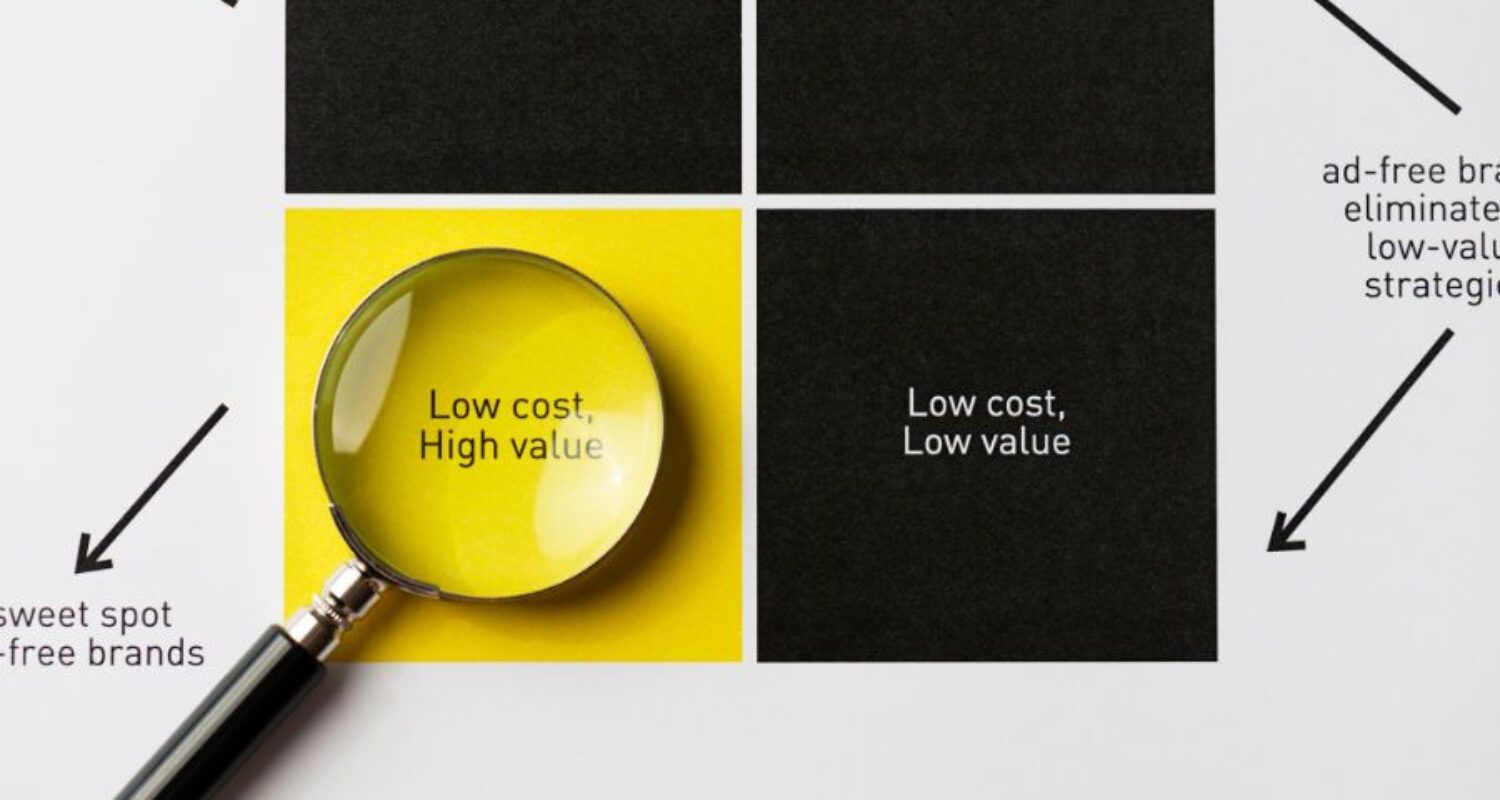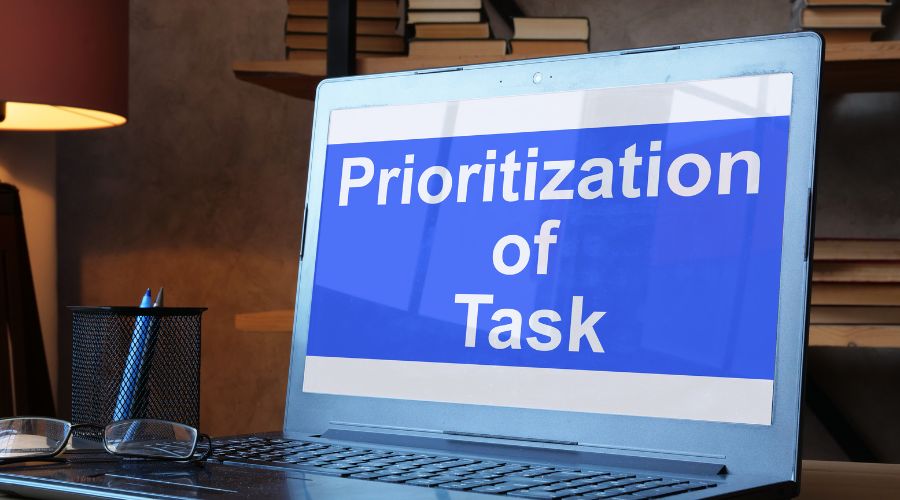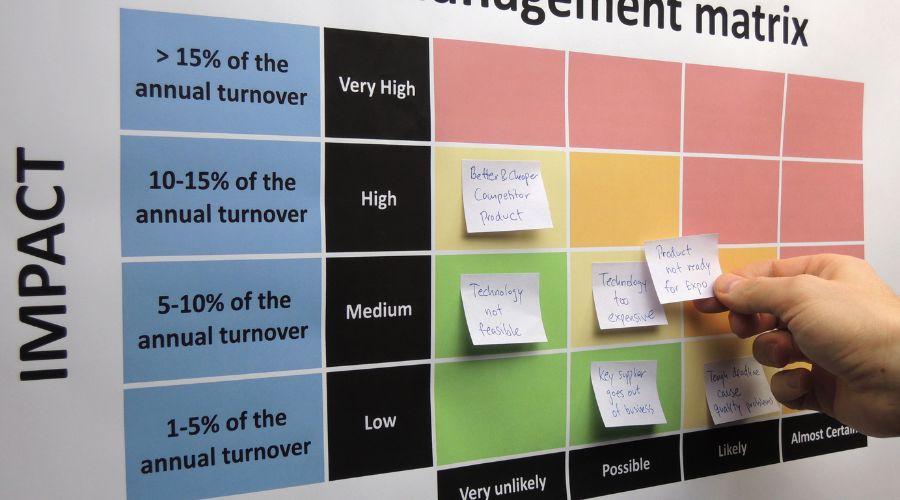Feeling overwhelmed by your to-do list? Struggling to tell urgent from important tasks? The Eisenhower Matrix could be your answer.
This tool, also known as the Urgent-Important Matrix, helps us sort tasks. It categorizes them by urgency and importance. This way, we can choose wisely and focus on what really counts for our business.
Key Takeaways:
- The Eisenhower Matrix divides tasks into four quadrants: Important/Urgent, Important/Non-Urgent, Unimportant/Urgent, and Unimportant/Non-Urgent.
- It helps us differentiate between tasks that require immediate attention and those that can be scheduled or delegated.
- Prioritizing tasks based on their urgency and importance can optimize our time management and enhance our overall productivity.
- The matrix was created by President Dwight D. Eisenhower and later popularized by author Stephen Covey.
- Implementing the Eisenhower Matrix can help us focus on the tasks that truly matter, rather than getting bogged down by distractions or time-wasters.
What is the Eisenhower Matrix?
The Eisenhower Matrix is a tool for managing your time and tasks. It helps you sort tasks by how urgent and important they are. You draw a square with two axes: Urgent vs. Not Urgent and Important vs. Not Important.
It breaks tasks into four groups. Do first, schedule later, delegate, or delete. Urgent tasks need quick action to avoid problems. Important tasks help achieve long-term goals and need careful planning.
- Quadrant 1 (Urgent & Important): Tasks needing immediate action, like deadlines.
- Quadrant 2 (Important, but not Urgent): Tasks for later that help long-term goals, like learning.
- Quadrant 3 (Not Important, but Urgent): Tasks to give to others, like requests from coworkers.
- Quadrant 4 (Neither Important nor Urgent): Tasks that distract and can be ignored.
Using the Eisenhower Matrix helps you focus on what’s most urgent and important. This way, you can be more productive and efficient.
History of the Eisenhower Matrix
The Eisenhower Matrix is a key tool for sorting tasks and managing time well. It comes from President Dwight Eisenhower’s career. He was a US Army general, Supreme Allied Commander, and the 34th President of the United States.
Eisenhower created the matrix to handle his many tasks. The 2×2 grid sorts tasks by urgency and importance. This became a key part of his decision-making and task management.
“What is important is rarely urgent, and what is urgent is rarely important.”
This quote shows the matrix’s core idea. It’s about knowing what’s truly important versus what’s just urgent. By focusing on what’s important, we can avoid getting lost in urgent tasks. This helps us achieve long-term goals.
The Eisenhower Matrix is widely used today. It helps in business and military planning. It’s great for prioritizing tasks, managing time, and making sure important work gets done.
How to Use the Eisenhower Matrix
Learning to prioritize tasks well is key for both people and businesses. The Eisenhower Matrix is a great tool for managing time. It was created by former U.S. President Dwight D. Eisenhower. It helps us sort tasks by how urgent and important they are.
The Eisenhower Matrix is a simple grid. It has urgency on one side and importance on the other. By sorting tasks into four areas, we can see where to spend our time and energy.
- The top right area is for tasks that are both urgent and important. We need to deal with these right away.
- The bottom right area is for tasks that are important but not urgent. These are often about long-term goals.
- The top left area is for tasks that are urgent but not important. We can often pass these on to others.
- The bottom left area is for tasks that are neither urgent nor important. We should try to avoid these or do them quickly.
Using the Eisenhower Matrix helps us make better choices about what to do first. It improves how we manage our time. This leads to success in work and life.
Adding the Eisenhower Matrix to our daily life can change everything. It reduces stress, boosts productivity, and helps us focus on what really matters. By using this tool well, we can reach our highest potential and achieve great success.
The Four Quadrants Explained
The Eisenhower Matrix is a tool for organizing tasks. It helps us focus on what’s urgent and important. Let’s explore the four quadrants and how they help us manage our time better.
Quadrant 1: Urgent and Important
Tasks in Quadrant 1 need our immediate action. They are emergencies, deadlines, and urgent matters. We should tackle these tasks first to prevent bigger problems.
Quadrant 2: Important, but Not Urgent
Quadrant 2 tasks are crucial for our future and growth. They include planning, learning, and solving problems. Even though they’re not urgent, they’re vital for our success.
| Quadrant | Description | Examples |
|---|---|---|
| 1. Urgent and Important | Do these tasks immediately | Crises, issues with deadlines |
| 2. Important, but Not Urgent | Schedule these tasks for later | Long-term projects, professional development |
Quadrant 3 (Not Important, but Urgent)
In the Eisenhower Matrix, Quadrant 3 is for tasks that are urgent but not important. These tasks can mess up your productivity and keep you from doing what really matters. Examples include helping colleagues, urgent emails, and other things that need quick attention but don’t help your long-term goals.
It’s key to handle these tasks, but spending too much time on them can make you feel stuck, frustrated, and stressed. The aim is to spend less time on these distractions. Instead, focus on tasks that are both urgent and important (Quadrant 1) or important but not urgent (Quadrant 2).
Delegating Quadrant 3 Tasks
One great way to deal with Quadrant 3 tasks is to pass them on to others. This lets you use your time for what’s really important. Here are some tips for delegating these tasks:
- Find tasks you can delegate and decide who should do them.
- Give clear instructions and deadlines to make sure they’re done right.
- Check in often to make sure the tasks are being done well.
- Help the person you’ve delegated to if they need it.
By delegating Quadrant 3 tasks, you can focus on what really matters for your business or personal goals. This method also helps your team grow and take on more responsibilities.
Eisenhower Matrix
The Eisenhower Matrix is a key tool for sorting tasks and managing time well. It was created by President Dwight D. Eisenhower. This tool sorts tasks by how urgent and important they are. It helps people and teams focus on what’s most important.
The matrix has four parts:
- Urgent and Important: Tasks that need quick action, like deadlines or emergencies.
- Important, but Not Urgent: Tasks that help achieve long-term goals, like planning or learning new skills.
- Urgent, but Not Important: Tasks that give quick satisfaction but don’t add much value, like checking emails or social media.
- Not Urgent and Not Important: Tasks that can be cut or given to others, like organizing files or browsing social media.
This way of sorting tasks helps people focus on the most important ones. It reduces stress and boosts productivity.
To get the most out of the Eisenhower Matrix template, try these tips:
- Set aside time for tasks in the “Important, but Not Urgent” quadrant. These tasks are key for long-term success.
- Give or automate tasks in the “Urgent, but Not Important” quadrant. This frees up time for more important work.
- Get rid of tasks in the “Not Urgent and Not Important” quadrant. They don’t add much value.
Using the Eisenhower Matrix can change the game for businesses and individuals. It helps streamline work, lowers stress, and boosts success. By focusing on urgent and important tasks, you can use your time better and do more meaningful work.
Tips for Task Prioritization
Getting tasks in order is key to being productive and reaching our goals. The Eisenhower Matrix is a great tool for managing tasks. With a few simple tips, we can use it to make our work flow better and work more efficiently.
Color-code tasks by priority level
Sorting tasks by urgency and importance helps us know what to do first. We can use colors like yellow for urgent and important tasks, green for important but not urgent ones, blue for urgent but not important, and pink for tasks that are neither urgent nor important. This makes it easy to see what needs our attention first.
Limit tasks per quadrant
It’s smart to limit tasks in each quadrant to avoid feeling overwhelmed. Experts say to keep each quadrant to ten tasks or less. This way, we can focus on the most critical tasks without feeling too stressed.
Separate personal and professional tasks
It’s good to have separate Eisenhower Matrices for work and personal life. This helps us prioritize better because work and personal tasks have different urgencies and importance. Keeping them separate helps us manage both areas of our lives well.
Eliminate unnecessary tasks first
Before we start prioritizing, we should get rid of tasks that aren’t important. Cutting out unimportant tasks saves time and mental energy for what really matters. This step helps us work more efficiently and avoid wasting time on tasks that don’t add value.
By following these task prioritization tips and using the Eisenhower Matrix wisely, we can boost our productivity, reduce stress, and make better choices in work and life.
Applying the Eisenhower Matrix
The Eisenhower Matrix is a useful tool for many roles. It helps people in different jobs to work better and make smart choices about what to do first.
For Product Owners
Product Owners can use the Eisenhower Matrix to organize their work. They sort tasks into four areas. This way, they focus on the most important and urgent tasks first.
This method helps them balance urgent tasks with long-term goals. It makes their product roadmap more successful and balanced.
For Project Managers
Project Managers use the Eisenhower Matrix to sort tasks. They find the most urgent and important tasks (Quadrant 1) and plan resources for them. This ensures projects are done on time.
They also give less important tasks (Quadrant 3) to team members. This frees up the manager’s time for big decisions.
For Directors of Product
Directors of Products use the Eisenhower Matrix to manage their product portfolio. They sort initiatives by urgency and importance. This helps them decide which projects to focus on, delegate, or stop.
This approach helps them align their team’s work with the company’s goals. It ensures resources are used wisely.
| Role | Eisenhower Matrix Application |
|---|---|
| Product Owner | Manage product backlog, prioritize user stories and features |
| Project Manager | Prioritize project tasks, mitigate scope creep, delegate less critical tasks |
| Director of Product | Oversee product portfolio, allocate resources, align with strategic objectives |
Professionals can improve their work by using the Eisenhower Matrix. It helps them work more efficiently and make better choices. This tool is useful for many people in different fields.
Conclusion
The Eisenhower Matrix is a great tool for sorting tasks and boosting productivity. It helps us decide how to spend our time by grouping tasks into four areas. This makes it easier to manage our work and life.
Key lessons from the Eisenhower Matrix include focusing on what’s important, letting go of less critical tasks, and finding a balance between work and life. These steps help us work better, feel less stressed, and reach our goals faster.
Whether you lead a team, manage projects, or just want to manage your time better, the Eisenhower Matrix can help. Using it in your daily tasks can lead to more success and achievement in your life.






